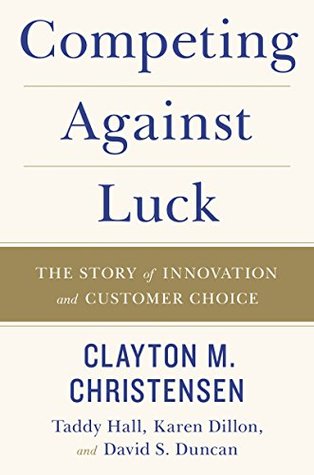More on this book
Community
Kindle Notes & Highlights
to my eye,
American Girl is
able to command a premium price because it’s not really selling dolls. It’s selling an experience.
“You’re not trying to just get the product out there, you hope you are creating an experience that will do the job perfectly,”
says Rowland. You’re creating experiences that, in effect, make up the product’s résumé: “Here’s why you should hire me.”
American Girl
dolls are about connection and empowering self-belief—and the chance to savor childhood just a bit longer.
Disruptive competitors almost never come with a better sense of the job.
They don’t see beyond the product.
“There’s no question in my mind that I came from the thesis that innovation succeeds when it addresses a job that needs to be done,”
The dolls were never sold in traditional toy stores, thrown in the mix alongside any number of competitors.
It turned out this added to the experience, turning a trip to the American Girl store into a special day out with mom (or dad).
The dolls become the catalyst for experiences with mom and dad that will be remembered forever.
All three layers—Uncovering the Job, Creating the Desired Experiences, and Integrating around the Job—are critical.
But no one has. Why not?
IKEA’s entire business model—the shopping experience, the layout of the store, the design of the products and the way they are packaged—is very different from the standard furniture store.
IKEA doesn’t focus on selling to any particular demographically defined group of consumers.
But what has been difficult to copy are the experiences that IKEA provides its customers—and the way it has anticipated and helped its customers overcome the obstacles that get in their way.
IKEA stores have a designated child-care area where you can leave your children to play while you wind your way through the store—and a café and ice cream stand to offer as a reward at the end.
Who is IKEA competing with?
The reason why we are willing to pay premium prices for a product that nails the job is because the full cost of a product that fails to do the job—wasted time, frustration, spending money on poor solutions, and so on—is significant to us.
You can only shape the experiences that are important to
your customers when you understand who you are really competing with.
That’s how you’ll know how to create your résumé to be ...
This highlight has been truncated due to consecutive passage length restrictions.
This is not what I mean about premium prices that customers are willing to pay.
By contrast, with jobs-based innovations, customers don’t resent the price, they’re grateful for the solution.
that succeed in solving customers’ jobs essentially perform services in that customer’s life.
Creating experiences and overcoming obstacles is how a product becomes a service to the customer, rather than simply a product with better features and benefits.
After you’ve fully understood a customer’s job, the next
step is to develop a solution that perfectly solves
successful growth companies optimize around the job.
to the root of my problem.
But really, the main organizing principle is a process to get the right things in the right sequence to get the job done.
Toyota wasn’t really worried that it would give away its “secret sauce.” Toyota’s competitive advantage rested firmly in its proprietary, complex, and often unspoken processes.
Amazon focuses on when orders are delivered not when they are shipped.
the key to successful innovation is to create and deliver the set of experiences corresponding to your customer’s job spec.
To do this consistently, a company needs to develop and integrate the right set of processes that deliver these experiences.
Doing so can yield a powerful source ...
This highlight has been truncated due to consecutive passage length restrictions.
advantage that is very difficult for o...
This highlight has been truncated due to consecutive passage length restrictions.
Most organizations do not have one person who is the “steward” ensuring the company consistently delivers against the customer’s job.
People don’t want to buy a quarter-inch drill. They want a quarter-inch hole.
It’s a profound insight—first popularized by legendary Harvard marketing professor Ted Levitt decades ago.1 Customers don’t want products, they want solutions to their problems.
rarely buys what the company thinks it sells him. There is, as these two sages pointed out, often a profound disconnect between the company and the customer. These are the two most important marketing insights of the last...
This highlight has been truncated due to consecutive passage length restrictions.
The origin story of most companies typically involves an entrepreneur identifying an important job that does not have an existing satisfactory solution, and developing a creative way to solve
As a company grows up, however, it’s very common for it to lose focus on the job that sparked its existence in the first place.
“What gets measured, gets done.”
Things change over time: growth requires additional layers of management and increased communication. Clear
Understanding the most important jobs your company solves for customers can be translated into a rallying cry that aligns individuals across the organization behind a common purpose and functions as an enduring innovation North Star.
Distributed decision making


